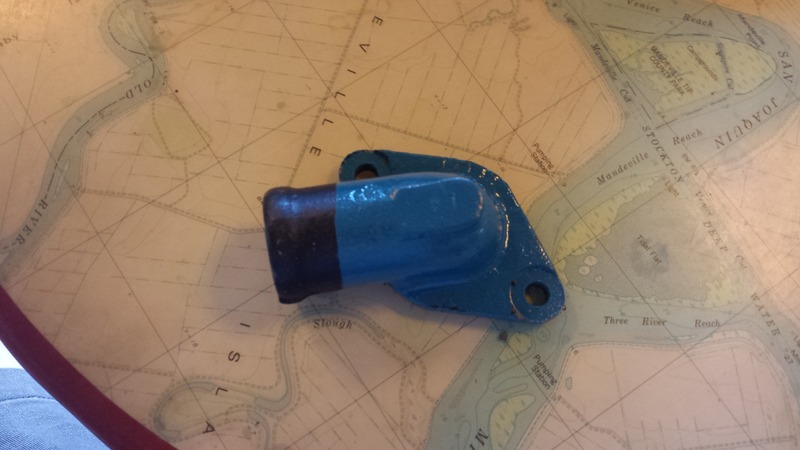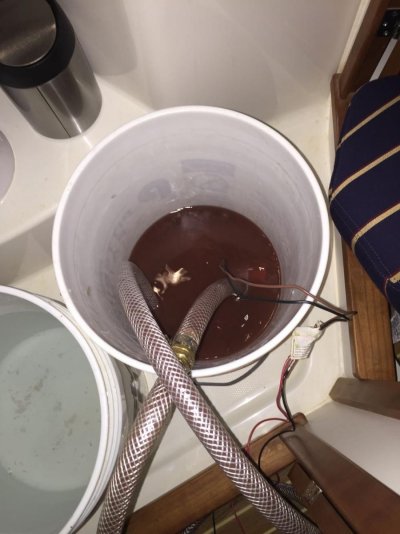- Joined
- Apr 15, 2008
- Messages
- 13,731
- Location
- California Delta
- Vessel Name
- FlyWright
- Vessel Make
- 1977 Marshall Californian 34 LRC
I've always dreamed of a day working on the boat when everything goes right, or nearly so, and the results and costs are better than expected. Yesterday I had that dream come true!
I've been troubleshooting temp creep on my port engine from its normal 180* to its new 197* at cruise power 1800 RPM. Slowing to 1600 RPM resulted in 187-190*. Power settings above 1800 resulted in temps of 199 or higher before I'd back down the power. I also had some coolant in the pan from the overflow and steam in the exhaust at cruise. Temps were verified on both helm gauges and laser-point thermometer on the engine.
I replaced the coolant reservoir caps as the old ones looked very old and were on the boat when I purchased it in 2007. I confirmed with the Perkins service shop that switching from 7 lb to 13 lb caps would be fine. I still had the temp creep and steam, but no more coolant in the pan.
At the recommendation of Dswizzler who had good luck with the product on his Detroits, I bought a one gallon bottle of Barnacle Buster concentrate from the mfr through Amazon. I received it 2 days later via Fedex, even though I got the non-Prime membership free shipping.
I picked up a cheap 500 GPH bilge pump for $20 and connected it to 3/4 and 1 in hoses. I disconnected the raw water output from the RW pump and connected the hose from the pump. The return line was connected to the water ejection nipple at the aft end of the exhaust manifold just upstream of the mixing elbow. This return hose fed back into the bucket with the BB and the bilge pump. All zincs were removed and the water line to my PSS was disconnected.
I found a cracked flange on my water ejection nipple but found a spare from years ago when I purchased parts for the stbd engine. I left the old piece in place for the flush and replaced it after 4 hrs of flushing.
Here's a shot of the broken and encrusted elbow taken after the flush and the replacement part.



After 4 hrs, I stopped the flush, ran a bucket of fresh water through the cooling system to remove the Barnacle Buster, then reconnected the system to the engine. Then Giggitoni and I took the boat for a spin to test the system.
We ran for an hour and never saw temps over 170* at cruise power. At WOT, I saw a peak of 175*. This is a 25*F improvement in the operating temps with minimal disassembly and cost.
From start to finish, it was a 7 1/2 hr job not counting the joy ride. This includes the 4 hr flush which allowed me to accomplish other tasks on the boat.
The cost of the job: $20 bilge pump, $72 gallon of Barnacle Buster concentrate that dilutes to 5 gallons of flush, enough for 2 Perkins 4.236 engine flushes. All hoses, fittings, etc I already owned.

I've been troubleshooting temp creep on my port engine from its normal 180* to its new 197* at cruise power 1800 RPM. Slowing to 1600 RPM resulted in 187-190*. Power settings above 1800 resulted in temps of 199 or higher before I'd back down the power. I also had some coolant in the pan from the overflow and steam in the exhaust at cruise. Temps were verified on both helm gauges and laser-point thermometer on the engine.
I replaced the coolant reservoir caps as the old ones looked very old and were on the boat when I purchased it in 2007. I confirmed with the Perkins service shop that switching from 7 lb to 13 lb caps would be fine. I still had the temp creep and steam, but no more coolant in the pan.
At the recommendation of Dswizzler who had good luck with the product on his Detroits, I bought a one gallon bottle of Barnacle Buster concentrate from the mfr through Amazon. I received it 2 days later via Fedex, even though I got the non-Prime membership free shipping.
I picked up a cheap 500 GPH bilge pump for $20 and connected it to 3/4 and 1 in hoses. I disconnected the raw water output from the RW pump and connected the hose from the pump. The return line was connected to the water ejection nipple at the aft end of the exhaust manifold just upstream of the mixing elbow. This return hose fed back into the bucket with the BB and the bilge pump. All zincs were removed and the water line to my PSS was disconnected.
I found a cracked flange on my water ejection nipple but found a spare from years ago when I purchased parts for the stbd engine. I left the old piece in place for the flush and replaced it after 4 hrs of flushing.
Here's a shot of the broken and encrusted elbow taken after the flush and the replacement part.



After 4 hrs, I stopped the flush, ran a bucket of fresh water through the cooling system to remove the Barnacle Buster, then reconnected the system to the engine. Then Giggitoni and I took the boat for a spin to test the system.
We ran for an hour and never saw temps over 170* at cruise power. At WOT, I saw a peak of 175*. This is a 25*F improvement in the operating temps with minimal disassembly and cost.
From start to finish, it was a 7 1/2 hr job not counting the joy ride. This includes the 4 hr flush which allowed me to accomplish other tasks on the boat.
The cost of the job: $20 bilge pump, $72 gallon of Barnacle Buster concentrate that dilutes to 5 gallons of flush, enough for 2 Perkins 4.236 engine flushes. All hoses, fittings, etc I already owned.

Last edited:


 What we used to flush our genny.
What we used to flush our genny.